Cookbook #194: Mexican Cookery for American Homes, Gebhardt’s, San Antonio, 1935.
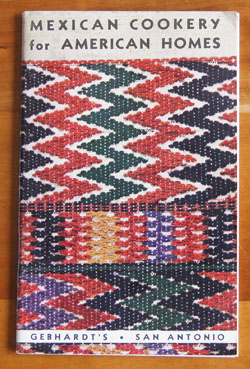
I am not sure how I acquired this cookbook, maybe it was Grandmother’s, or maybe it came from the Ruth C. Vandenhoudt house. One recipe – Chili Meat Loaf – has a handwritten note, but I’m not sure whose writing it is.
Mexican Cookery for American Homes was produced by the manufacturer of a chile powder: Gebhardt. Almost every recipe calls for either Gebhardt’s chili powder or Gebhardt’s canned chili.
An earlier version (c1923) of Mexican Cookery for American Homes is available in full text on the Hathi Trust web site. An even earlier version is now available as a reprint. The back cover of this 2005 reprint, compiled by Andrew F. Smith, a teacher of culinery history, reads:
“The Gebhardt Chili Powder Company was founded by William Gebhardt, a German, who migrated about 1885 to New Braunfels, Texas. Gebhardt opened a café, which served chilis imported from Mexico. To preserve them, he dried and crushed them into powder. He began bottling his powder, and in 1890, he opened a factory to San Antonio. Six years later he trademarked the name “Gebhardt’s Eagle Brand Chili Powder.” The powder became an important ingredient to such an extent that recipes in Texas cookbooks specifically recommended its use. When Gebhardt began marketing chili powder to a wider audience beyond Texas, he ran into a very serious problem-consumers not familiar with Tex-Mex cookery had little idea what to do with it. To help cooks understand Tex-Mex cookery, Gebhardt produced a small 32-page cookery pamphlet. This cookbooklet was originally published about 1908. As such, it was the first English-language booklet published in the United States that focused on Mexican-American cookery. It proved so successful that new editions of it were regularly published through the 1950s. In 1911, Gebhardt sold his company to his brothers-in-law, who expanded their product line to include beans and tamales. During the 1920s, they introduced to the tourist trade Gebhardt’s Original Mexican Dinner Package, consisting of cans of chili con carne, Mexican Style Beans, shuck-wrapped Tamales, Deviled Chili Meat, and a bottle of Chili Powder-all for one dollar. By the 1930s, Gebhardt products were sold throughout the United States and Mexico. The company survived until 1960 when it was purchased by Beatrice Foods, which in turn was acquired by ConAgra in 1990.” (From Amazon description accessed 2017.)
My 1935 edition of Mexican Cookery for American Homes reflects the culture of America at the time – women were the home cooks. I’ve addressed the issue of women-in-the-kitchen many times in this blog, most recently in this post. The foreword (below) to Mexican Cookery for American Homes states in the last paragraph: “Earlier editions of ‘Mexican Cookery for American Homes’ have been welcomed by countless thousands of women.”
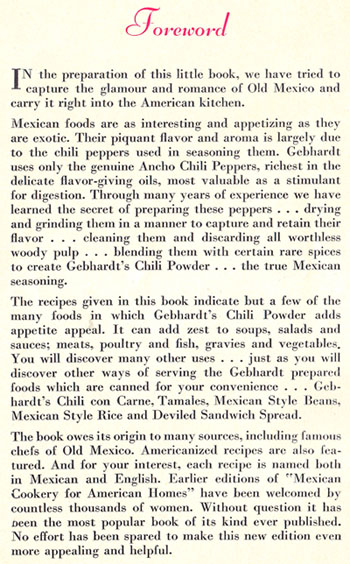
I found a post about Mexican Cookery for American Homes on a website by another affectionado of old cookbooks, Wendi. The blog is called “Resurrected Recipes, this is your grandma’s cooking“. Wendi has the same version of Mexican Cookery for American Homes that I do. I like her discussion of the recipes, recipes quite different from the Mexican foods we have today, or even the recipes in the 1950-60s era of cookbooks. She calls some of them silly! Like this recipe for “Gebhardt’s Tamales and Chili with Meat”:
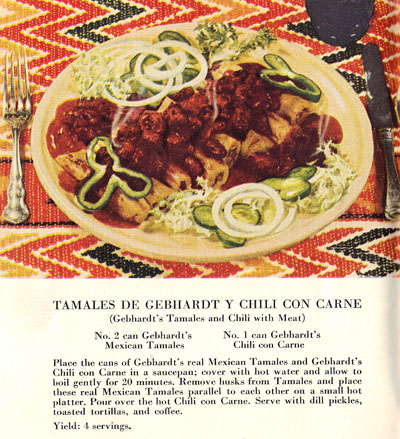
Yup, you put two cans – unopened – in boiling water for 20 minutes! Silly indeed.
I decide to make “Enchiladas, Mexican Style for this blog”. It’s the middle recipe in the scan below – I included the other recipes for curiousity’s sake.
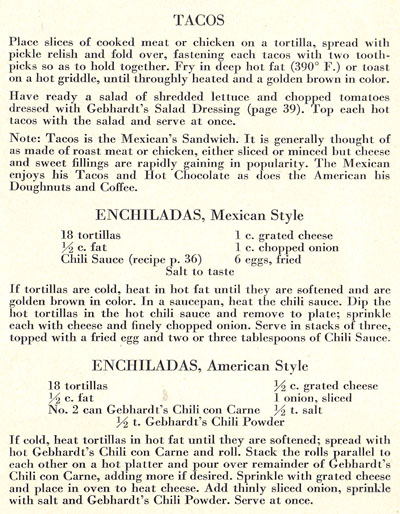
Note that the Mexican style of enchilada is served on flat – not rolled – tortillas. And, you put fried eggs on top. Another twist! I’ve put poached eggs on tortillas and beans to make Huevos Rancheros and we’ve always like them.
This enchilada recipe calls for Chili Sauce on page 36:

I’ll make these pretty much as the recipe reads. Except, I do not want to fry the tortillas, instead I’ll soften them in the microwave. I don’t have Gebhardt’s chili powder, but I have some great chili powder from Savory Seasonings.
Enchiladas with Eggs
serves 2 for dinner
- 1 small onion, diced
- 1/4 bell pepper, diced
- 1 clove garlic, minced
- 2 tablespoons flour
- 1 tablespoon hot chili powder
- 1/2 teaspoon salt
- 1 cup chopped tomaotes (fresh or canned)
- 1 cup beef stock (or water)
- 6 corn tortillas
- 1/2 to 1 cup grated cheese (I used cheddar cheese)
- a few diced onions, if desired
- 1-2 eggs, fried or poached
To make the sauce, cook the diced onion, bell pepper, and garlic in a little oil until soft. Combine the flour, chili powder, and salt, then add to the cooked onion mixture and stir until smooth. Slowly stir in the tomatoes and beef stock (or water) and simmer about 20 minutes.
On each plate, layer 3 tortillas with a little sauce and cheese between each layer. Microwave on high until the cheese and sauce are bubbly – probably less than a minute. Top with fried egg(s) and serve.
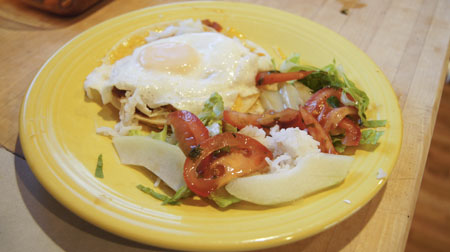
I served these enchiladas with a little lettuce, rice, tomatoes in a balsamic vinaigrette, and chayote. (More on chayote below.) This meal was a success! I really enjoyed the mixture of egg, tortillas, cheese and seasonings – a different taste for dinner. Hubby said he’d prefer it with refried beans, more like traditional huevos rancheros. Maybe next time.
Chayote
Chayote is a member of the gourd (squash) family, as I learned when I read my 1928 Salads, Vegetables and the Market Basket. Chayote is common in Latin American cooking, but is not listed in Mexican Cookery for American Homes. Last week I was at my favorite Asian Seafood Market and found a chayote in the fresh produce area. I brought it home because it looked so interesting! I served it with a mixture of tomatoes and balsamic vinegar:
 Here’s the sliced, peeled chayote. It tastes like something between an apple and a pear, crunchy and interesting.
Here’s the sliced, peeled chayote. It tastes like something between an apple and a pear, crunchy and interesting. 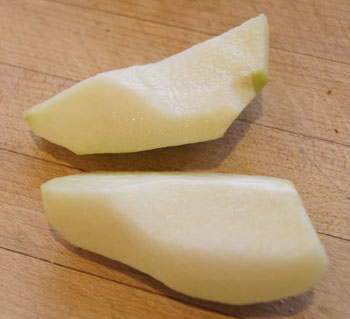 My tomato vinaigrette is a modification of a recipe for “Spicy Balsamic Tomato Salad” that I found on allrecipes.com.
My tomato vinaigrette is a modification of a recipe for “Spicy Balsamic Tomato Salad” that I found on allrecipes.com.
- 2 tomatoes, cut into thin wedges
- 1 tablespoon balsamic vinegar
- 1 tablespoons rice vinegar
- basil to taste, dried or fresh
- 1/4 teaspoon ground ginger
- salt to taste
- chayote, peeled and sliced
Combine tomatoes and vinegar and seasonings. Let sit, stirring every 15, until flavors combine, about 1 hour. Combine with sliced chayote and serve.

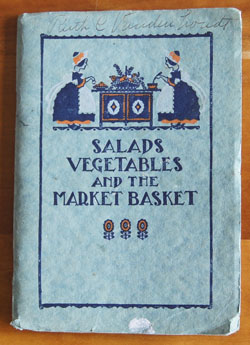
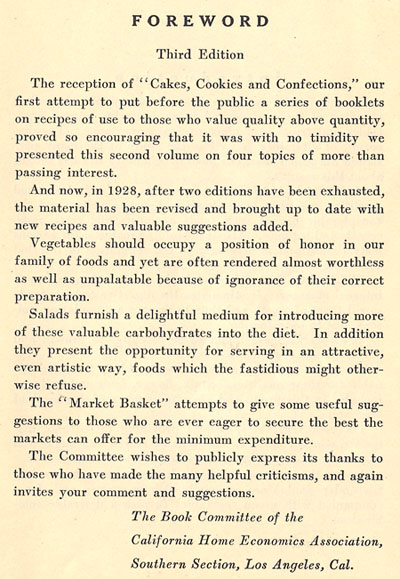

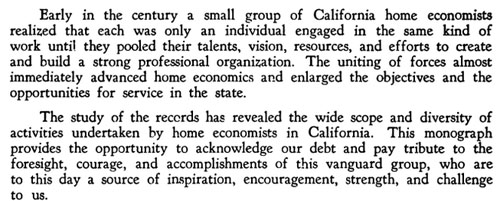

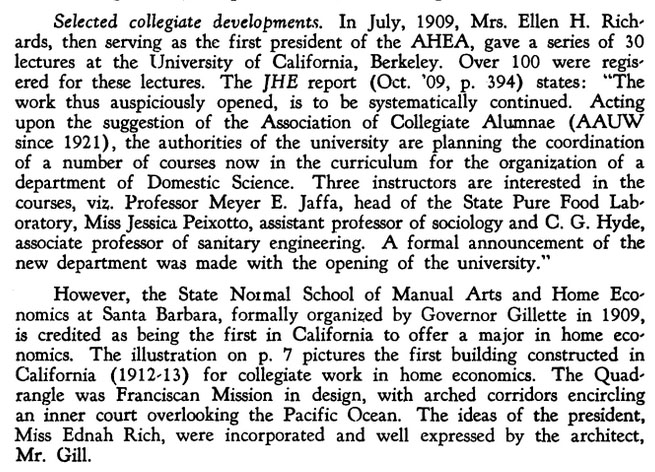 The following is the beginning of an appendix in The California Home Economics Association, yesterday, today, and tomorrow, 1921-1961. It dilineates the early introduction of home economics to California schools. Note the last entry on “hand and machine sewing”. I learned sewing (as well as cooking) in junior high in California in the 1950s.
The following is the beginning of an appendix in The California Home Economics Association, yesterday, today, and tomorrow, 1921-1961. It dilineates the early introduction of home economics to California schools. Note the last entry on “hand and machine sewing”. I learned sewing (as well as cooking) in junior high in California in the 1950s.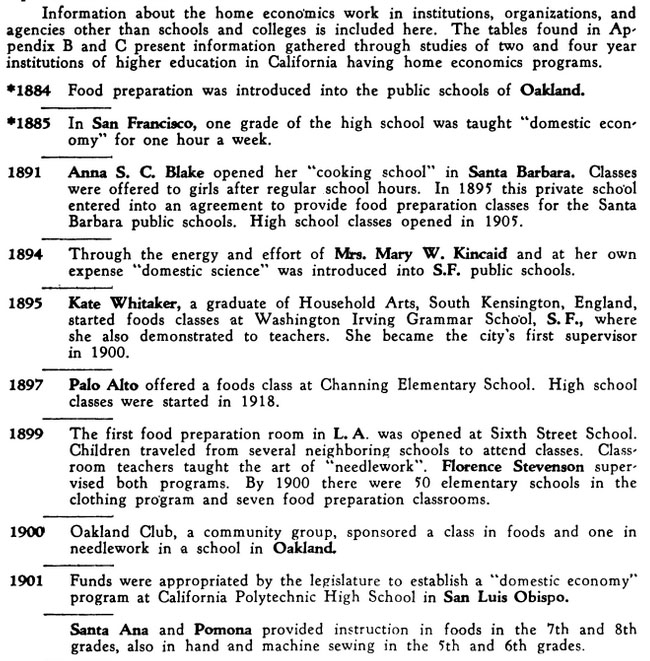 By the 1960s, American home kitchens are influenced by many changes: industrialization, urbanization, suburbanization, working mothers, a higher level of education, and automation.
By the 1960s, American home kitchens are influenced by many changes: industrialization, urbanization, suburbanization, working mothers, a higher level of education, and automation.
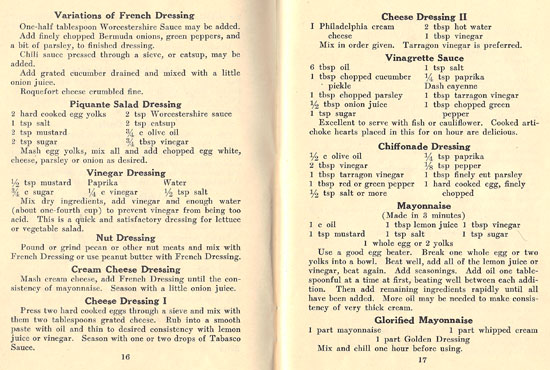
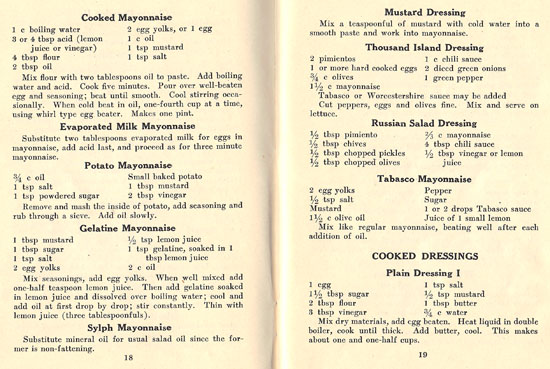 Some salads have fancy presentations, like Butterfly Salad, or Banana Canoes.
Some salads have fancy presentations, like Butterfly Salad, or Banana Canoes.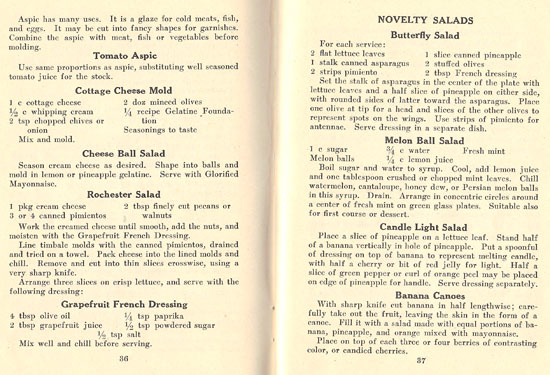
 Glazed Carrots with Peas with Mint
Glazed Carrots with Peas with Mint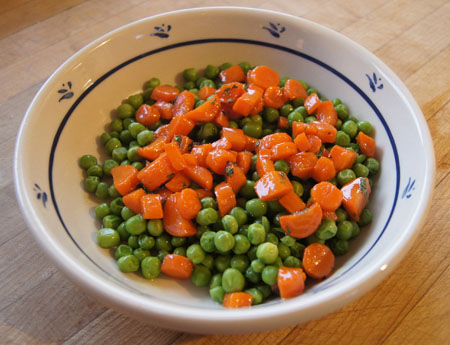 I thought these were good – hubby was less impressed. I love the colors and the bright mint flavor. Yes, they were a bit sweet, but I thought it nice for a change.
I thought these were good – hubby was less impressed. I love the colors and the bright mint flavor. Yes, they were a bit sweet, but I thought it nice for a change.
 I decide to look for red-in-snow at the Asian Seafood Market on 28th St. in Boulder. Nothing under that name in the store, but I did find pickled mustard greens:
I decide to look for red-in-snow at the Asian Seafood Market on 28th St. in Boulder. Nothing under that name in the store, but I did find pickled mustard greens: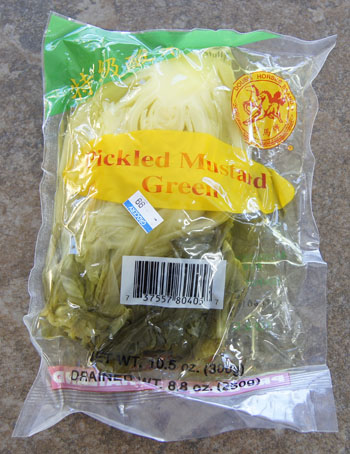
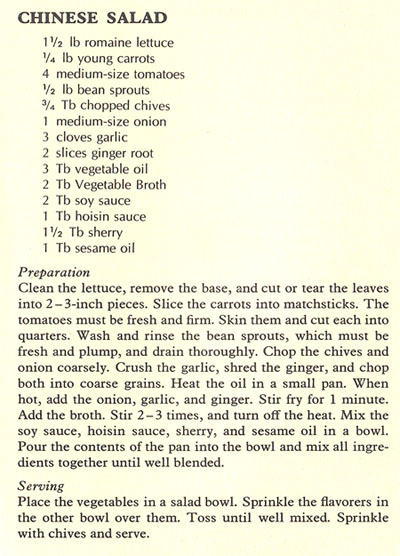 I pick up some bean sprouts for this salad at the Asian Seafood Market. I really like that this market sells bean sprouts in bulk – most stores sell them in packages, and the two of us can never finish them before they go bad. I don’t find chives, but pick up a bunch of green onions; these too are always good a the Asian Seafood Market. I get some ginger, and a big baggie of peeled garlic ($1.50!). I decide to put some of the pickled mustard greens in the salad to see what they taste like. I don’t have and sherry, but decide to substitute with a little rice wine vinegar. It’s not in the salad, but I buy a big bag of bok choy (the storeowner always gives me grief when I just buy a couple bok choys).
I pick up some bean sprouts for this salad at the Asian Seafood Market. I really like that this market sells bean sprouts in bulk – most stores sell them in packages, and the two of us can never finish them before they go bad. I don’t find chives, but pick up a bunch of green onions; these too are always good a the Asian Seafood Market. I get some ginger, and a big baggie of peeled garlic ($1.50!). I decide to put some of the pickled mustard greens in the salad to see what they taste like. I don’t have and sherry, but decide to substitute with a little rice wine vinegar. It’s not in the salad, but I buy a big bag of bok choy (the storeowner always gives me grief when I just buy a couple bok choys).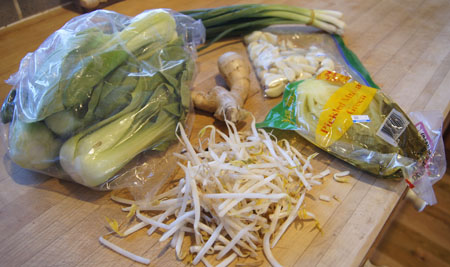
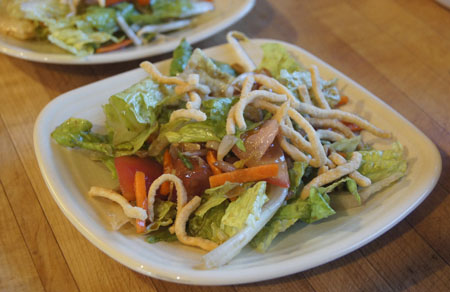
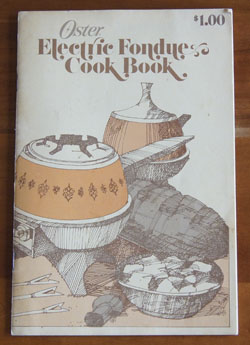 That lovely decade when my husband and I were in our twenties . . . many memories. Among those memories are certain yummy and often fattening foods. Like fondues. Our party friends with us, the fondue pot filled with a beer-cheese-spice mixture, big, slurpy, cheesy mouthfuls scooped up by homemade tortilla chips. Back in the day. It was fun.
That lovely decade when my husband and I were in our twenties . . . many memories. Among those memories are certain yummy and often fattening foods. Like fondues. Our party friends with us, the fondue pot filled with a beer-cheese-spice mixture, big, slurpy, cheesy mouthfuls scooped up by homemade tortilla chips. Back in the day. It was fun.
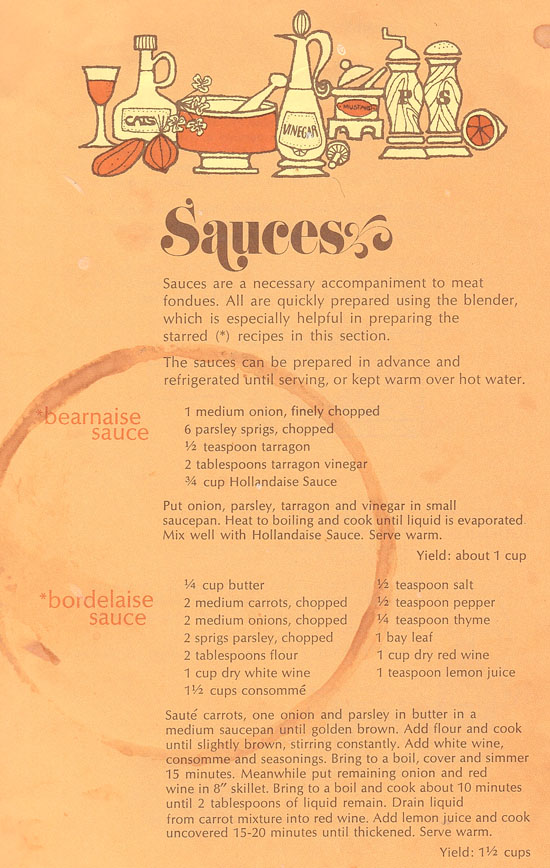
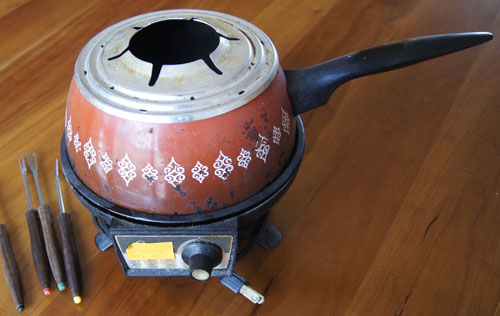 Here is my chunky bernaise sauce:
Here is my chunky bernaise sauce: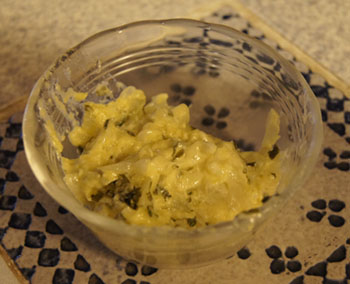
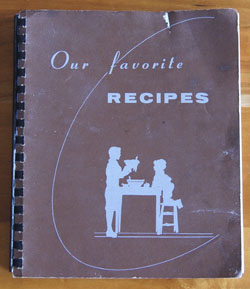
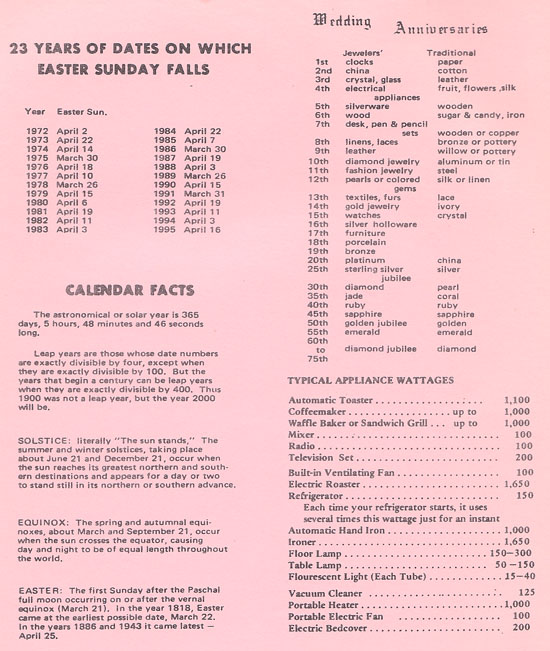
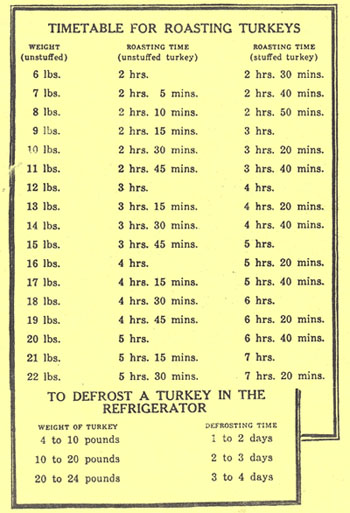
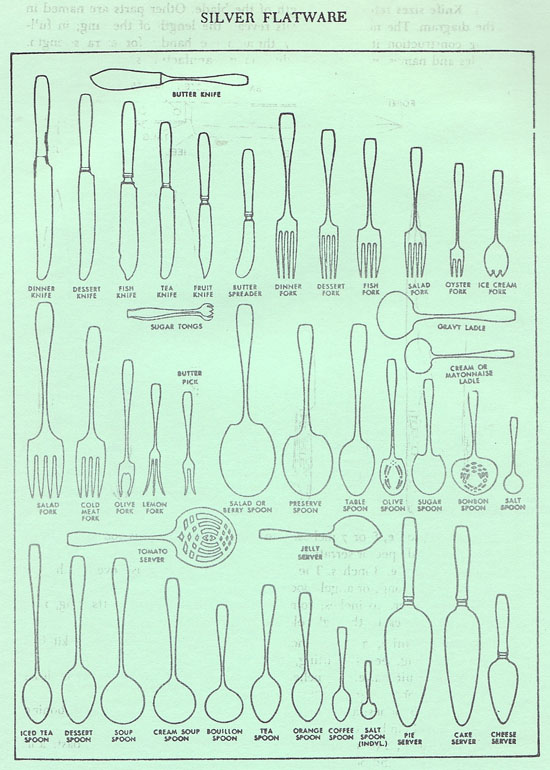
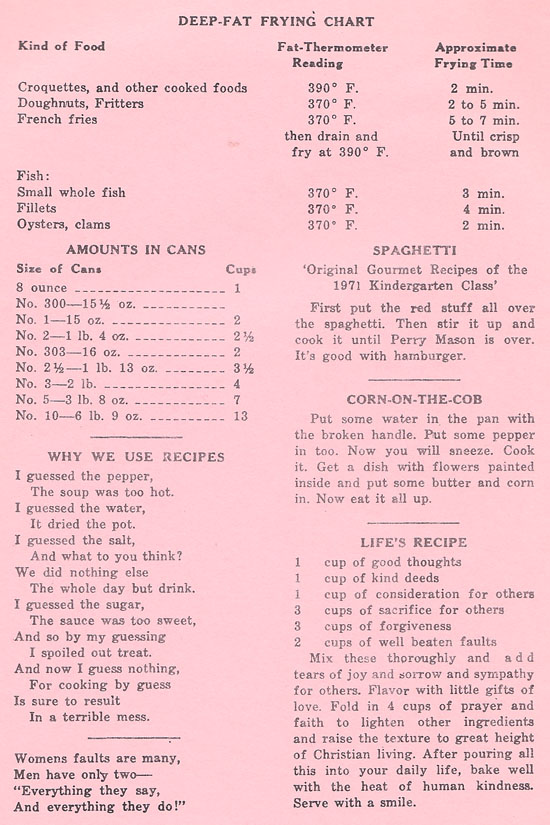
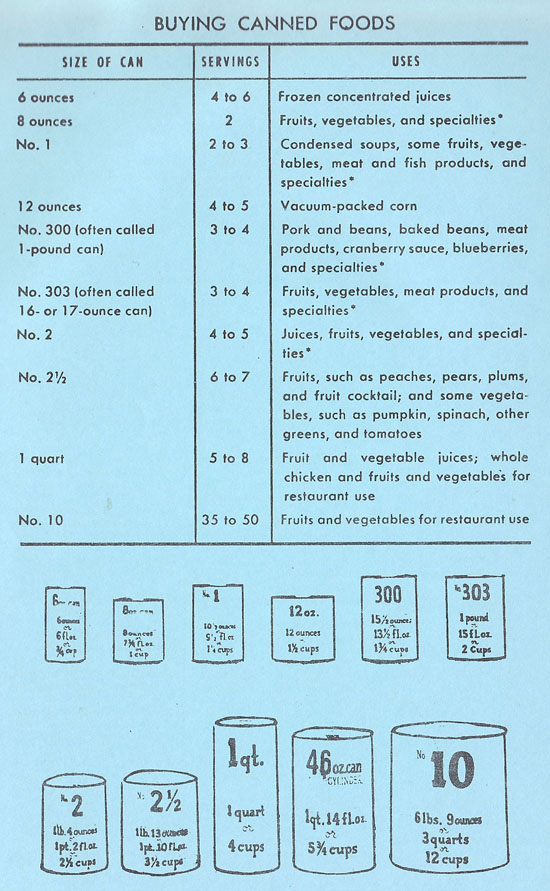
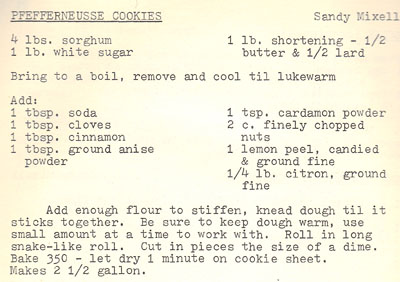


 I think there is a bit too much sugar in this recipe, I prefer butter to shortening (and less), I will use active dry yeast yeast, I want to make only half a recipe, and I want to use my breadmaker. My version of this recipe is below.
I think there is a bit too much sugar in this recipe, I prefer butter to shortening (and less), I will use active dry yeast yeast, I want to make only half a recipe, and I want to use my breadmaker. My version of this recipe is below.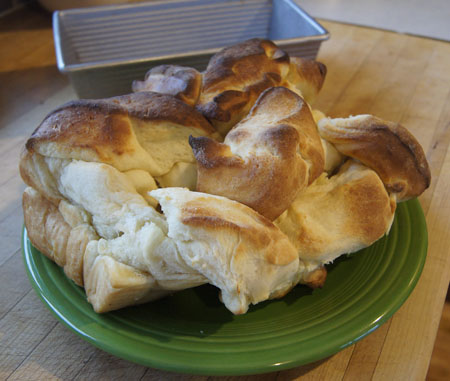 As you can see, my bread rose crazily! That’s why I suggest a bundt pan next time. Usually a 9×5-inch loaf pan is big enough for 2 1/2 cups flour – but this time it obviously wasn’t!
As you can see, my bread rose crazily! That’s why I suggest a bundt pan next time. Usually a 9×5-inch loaf pan is big enough for 2 1/2 cups flour – but this time it obviously wasn’t! I have a set of twelve Encyclopedia of Cookery volumes and this is the ninth of that set – I covered the first eight in previous posts. I’ve enjoyed all of them so far! This volume covers curious and helpful information about foods from pec(tin) to pur(ée).
I have a set of twelve Encyclopedia of Cookery volumes and this is the ninth of that set – I covered the first eight in previous posts. I’ve enjoyed all of them so far! This volume covers curious and helpful information about foods from pec(tin) to pur(ée).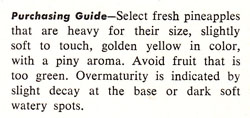 Pimientos are red bell peppers. It is interesting that red bell peppers are actually green bell peppers that have reached a further state of maturity. The pimiento variety of bell peppers are heart-shaped and very sweet. You can find them canned in the markets, often in small glass jars. I usually substitute fresh red bell peppers for pimientos in recipes.
Pimientos are red bell peppers. It is interesting that red bell peppers are actually green bell peppers that have reached a further state of maturity. The pimiento variety of bell peppers are heart-shaped and very sweet. You can find them canned in the markets, often in small glass jars. I usually substitute fresh red bell peppers for pimientos in recipes.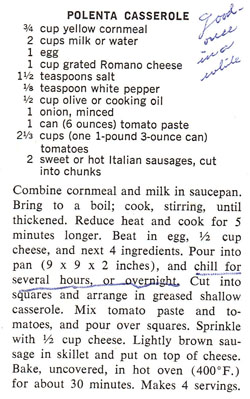
 From the same article by Beard: “Eliza Acton, in her magnificent book of Modern Cookery, published in London in 1848, quotes the following ‘genuine Irish receipt’ for boiling potatoes”:
From the same article by Beard: “Eliza Acton, in her magnificent book of Modern Cookery, published in London in 1848, quotes the following ‘genuine Irish receipt’ for boiling potatoes”:
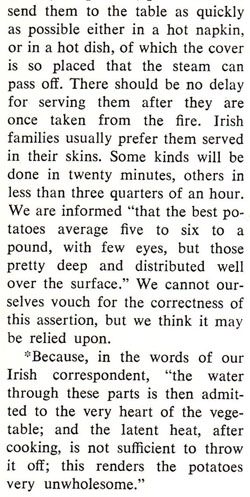

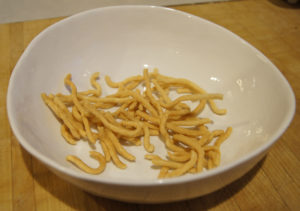
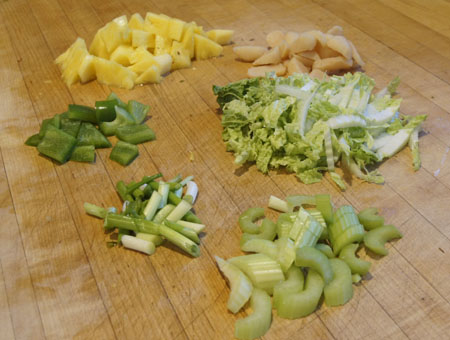
 The completed dish:
The completed dish: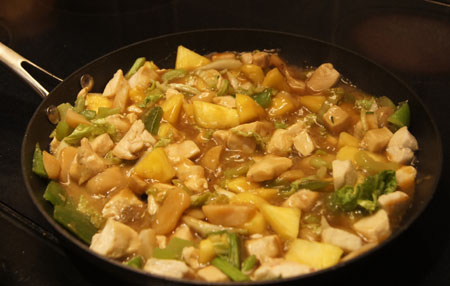 This was excellent, worth making again! It’s fast and easy, and I like the fresh pineapple in it. I liked it over crunchy chow mein noodles, but any Oriental noodle or rice would also work well with this dish.
This was excellent, worth making again! It’s fast and easy, and I like the fresh pineapple in it. I liked it over crunchy chow mein noodles, but any Oriental noodle or rice would also work well with this dish.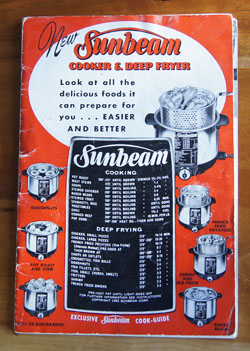 My Sunbeam deep fryer spends most of its time down on a shelf in the basement. It is greasy and old and just the thought of deep-frying sends fears of high calorie food into my healthy eating plan. Even though I read (and mostly believed)
My Sunbeam deep fryer spends most of its time down on a shelf in the basement. It is greasy and old and just the thought of deep-frying sends fears of high calorie food into my healthy eating plan. Even though I read (and mostly believed) 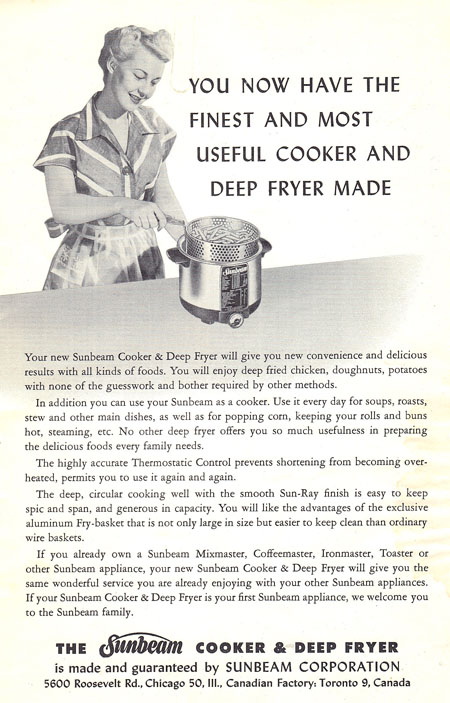 The Sunbeam Cooker and Deep Fryer booklet advises the cook to use solid vegetable shortening, such as “Spry”, a product I discussed in my blog entry for the 1942 cookbook
The Sunbeam Cooker and Deep Fryer booklet advises the cook to use solid vegetable shortening, such as “Spry”, a product I discussed in my blog entry for the 1942 cookbook 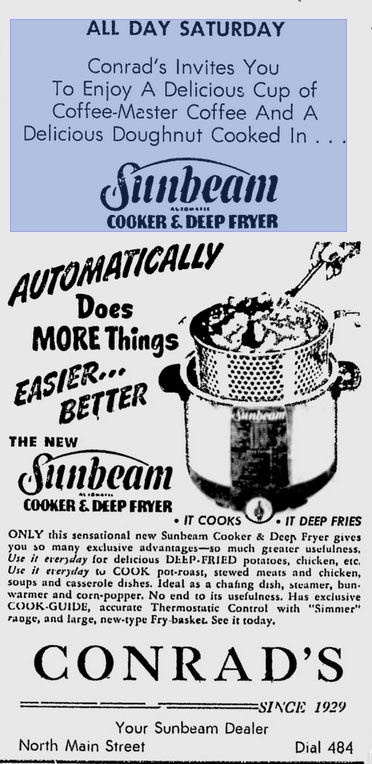
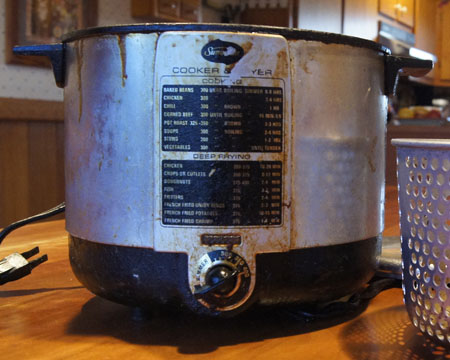 Cleaned up, it doesn’t look a whole lot better. Some of the paint came off before I realized it was happening.
Cleaned up, it doesn’t look a whole lot better. Some of the paint came off before I realized it was happening.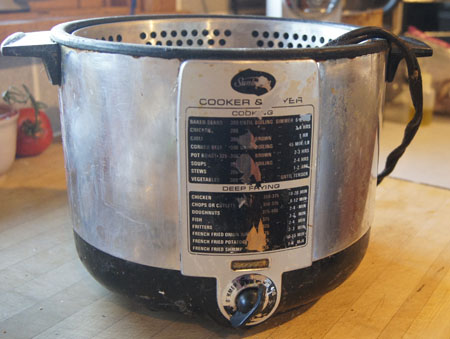 Below is the scanned-in recipe for Old Fashioned Doughnuts in the Sunbeam Cooker and Deep Fryer booklet. I can tell from all the grease splashes that I have used the doughnut recipe before:
Below is the scanned-in recipe for Old Fashioned Doughnuts in the Sunbeam Cooker and Deep Fryer booklet. I can tell from all the grease splashes that I have used the doughnut recipe before: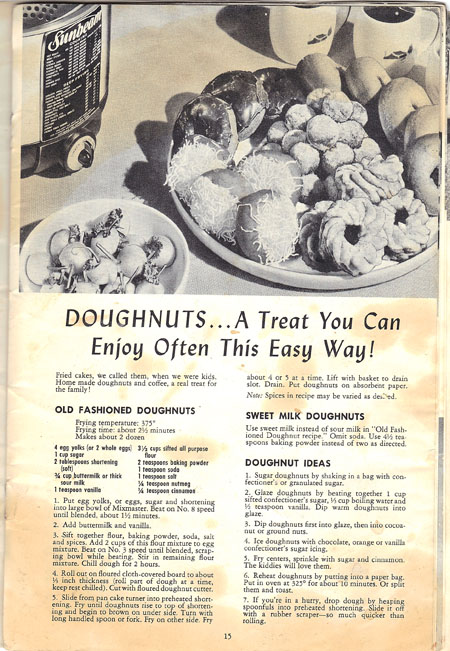
 Here are the doughnuts cooked and glazed. I found out on the next batch that it helps to keep the glaze hot so that it covers the doughnuts better. These look a bit sloppy, but they tasted delightful!
Here are the doughnuts cooked and glazed. I found out on the next batch that it helps to keep the glaze hot so that it covers the doughnuts better. These look a bit sloppy, but they tasted delightful!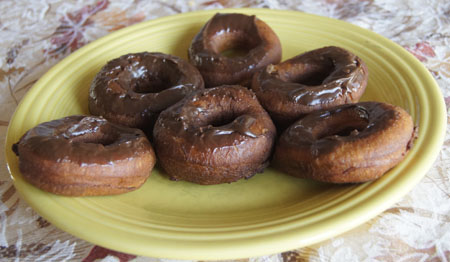 I cooked the “Old Fashioned Doughnuts” too. They were sweeter with a nice hint of spices. I recommend both recipes!
I cooked the “Old Fashioned Doughnuts” too. They were sweeter with a nice hint of spices. I recommend both recipes!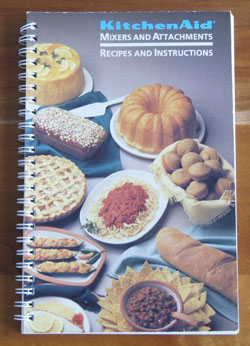
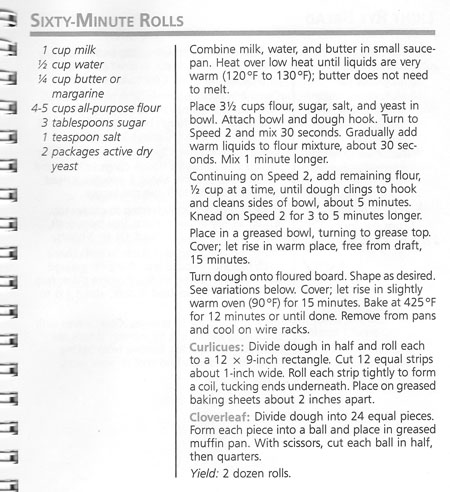
 Here are the rolls, ready for the oven after the first rise. They rose to just above the top of the muffin tin.
Here are the rolls, ready for the oven after the first rise. They rose to just above the top of the muffin tin.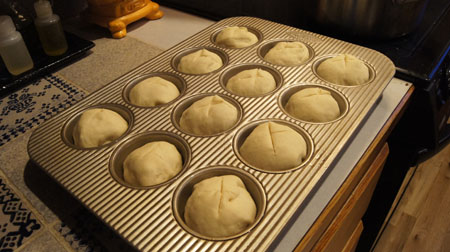 And here are the golden brown rolls, baked:
And here are the golden brown rolls, baked: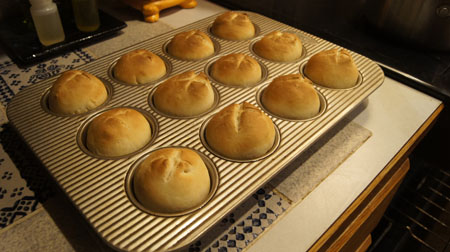
 Note: I put the extra rolls in the freezer. A week later, I need bread for a dinner, so I popped three in the microwave on high for 60 seconds. Perfect! Now these are “60 second 60 minute rolls”.
Note: I put the extra rolls in the freezer. A week later, I need bread for a dinner, so I popped three in the microwave on high for 60 seconds. Perfect! Now these are “60 second 60 minute rolls”.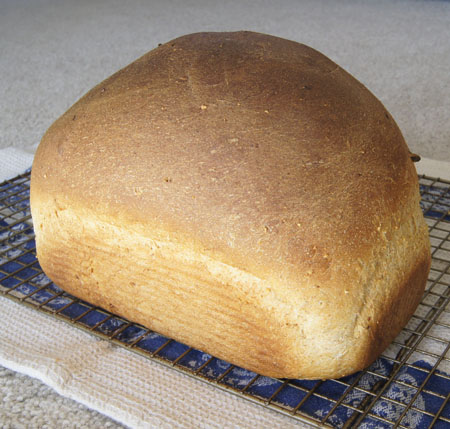
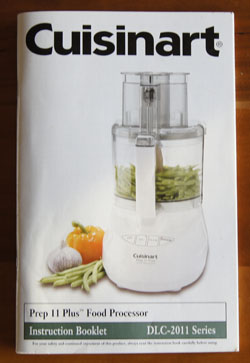 This is the instruction booklet for my first Cuisinart, a DLC-2011 series, that I gave to my daughter a year ago. It is still a working unit, although over the years I had some issues with the top and its attachment to the working bowl. (And now the blade has been recalled due to issues with the rivets in the blade falling apart.)
This is the instruction booklet for my first Cuisinart, a DLC-2011 series, that I gave to my daughter a year ago. It is still a working unit, although over the years I had some issues with the top and its attachment to the working bowl. (And now the blade has been recalled due to issues with the rivets in the blade falling apart.)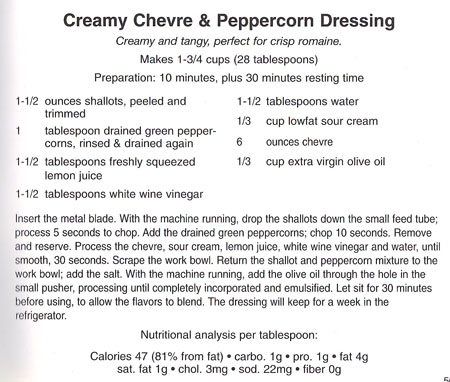 “Chevre” is more commonly called “goat cheese”, at least where we live. I have used green peppercorns before (ages ago), and they were packed in brine, as called for in the printed Creamy Chevre & Peppercorn Dressing recipe. According to my
“Chevre” is more commonly called “goat cheese”, at least where we live. I have used green peppercorns before (ages ago), and they were packed in brine, as called for in the printed Creamy Chevre & Peppercorn Dressing recipe. According to my 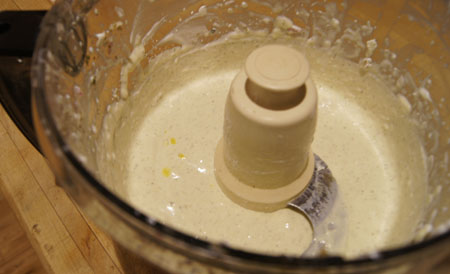
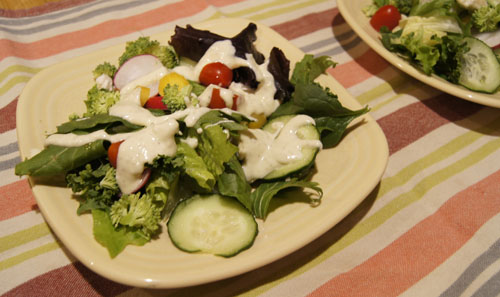 He ended up choosing the goat cheese dressing, and he liked it! He even chose it the next night too.
He ended up choosing the goat cheese dressing, and he liked it! He even chose it the next night too.